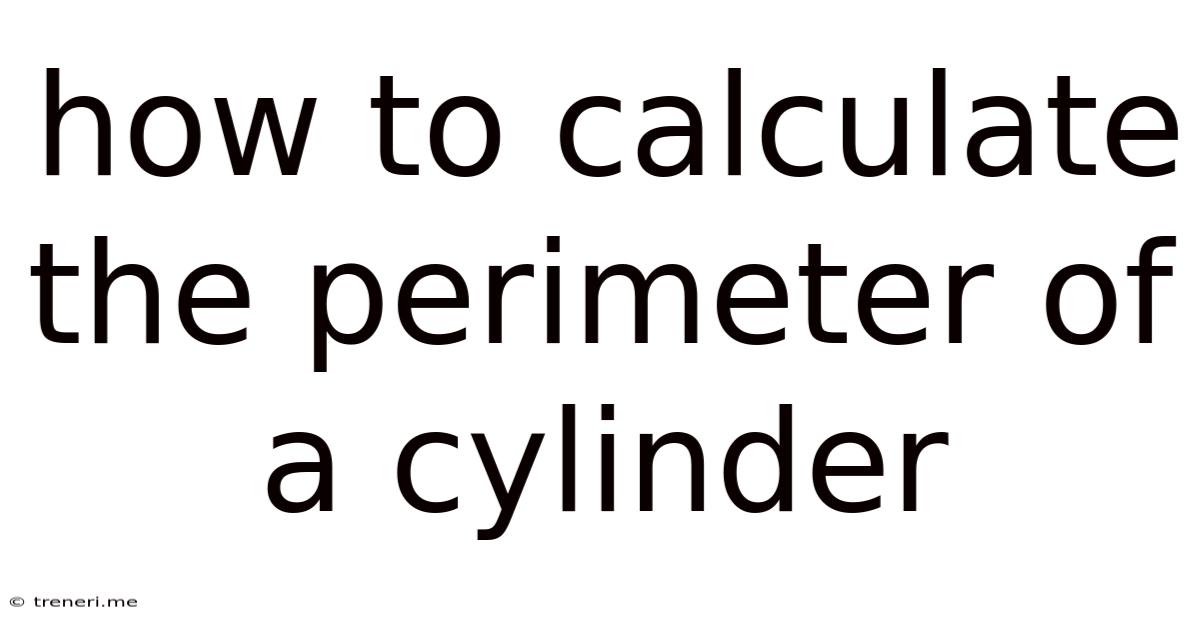How To Calculate The Perimeter Of A Cylinder
Treneri
May 13, 2025 · 4 min read

Table of Contents
How to Calculate the Perimeter of a Cylinder: A Comprehensive Guide
The term "perimeter" typically refers to the distance around a two-dimensional shape. A cylinder, however, is a three-dimensional object. Therefore, we can't directly calculate a single "perimeter" like we would for a square or circle. Instead, we need to consider different aspects of the cylinder's dimensions and specify which perimeter we are trying to calculate. This guide will delve into the various ways to calculate the distances around different parts of a cylinder, clarifying common misunderstandings and providing step-by-step instructions.
Understanding Cylinder Dimensions
Before we embark on calculating perimeters, let's define the key components of a cylinder:
- Radius (r): The distance from the center of the circular base to any point on the circumference.
- Diameter (d): Twice the radius (d = 2r). The distance across the circle through the center.
- Height (h): The perpendicular distance between the two circular bases.
Understanding these dimensions is crucial for calculating the different "perimeters" we'll discuss.
Calculating the Circumference of the Circular Base
The most common interpretation of a cylinder's perimeter is the circumference of its circular base. This is the distance around one of the circular ends. The formula for circumference is:
Circumference (C) = 2πr
where:
- C represents the circumference.
- π (pi) is a mathematical constant, approximately 3.14159.
- r is the radius of the circular base.
Example:
Let's say a cylinder has a radius of 5 cm. To find its base circumference:
C = 2 * π * 5 cm ≈ 31.42 cm
Therefore, the circumference of the circular base is approximately 31.42 centimeters. Remember to always include the units in your answer.
Calculating the Lateral Surface Perimeter
The lateral surface of a cylinder is the curved surface that connects the two circular bases. To find the perimeter-like measurement of this surface, we need to imagine "unrolling" the cylinder into a rectangle.
The length of this rectangle is equal to the height (h) of the cylinder, and the width is equal to the circumference (C) of the circular base. The perimeter of this rectangle, representing the lateral surface perimeter, is:
Lateral Surface Perimeter (LSP) = 2 * (height + circumference) = 2(h + 2πr)
Example:
Consider a cylinder with a radius of 3 cm and a height of 10 cm.
LSP = 2 * (10 cm + 2 * π * 3 cm) ≈ 2 * (10 cm + 18.85 cm) ≈ 57.7 cm
Therefore, the lateral surface perimeter is approximately 57.7 centimeters. Note this is not a true perimeter in the traditional sense, but rather a measurement of the distance around the unrolled lateral surface.
Calculating the Total Surface Area (Related but not a Perimeter)
While not a perimeter, understanding the total surface area is often confused with calculating perimeter. The total surface area encompasses the area of both circular bases and the lateral surface. The formula is:
Total Surface Area (TSA) = 2πr² + 2πrh = 2πr(r + h)
Where:
- 2πr² represents the area of both circular bases.
- 2πrh represents the area of the lateral surface.
Example:
Using the same cylinder (r = 3 cm, h = 10 cm):
TSA = 2 * π * 3 cm * (3 cm + 10 cm) ≈ 2 * π * 3 cm * 13 cm ≈ 245.04 cm²
This is the total area of the cylinder’s surface, expressed in square centimeters, not a linear distance.
Addressing Common Misconceptions
Many sources incorrectly state that a cylinder has a single perimeter. It's vital to understand that the term "perimeter" is not directly applicable to a 3D shape in the same way it is to a 2D shape. The calculations above represent different ways to measure distances around various aspects of the cylinder.
Practical Applications
Calculating these distances is vital in numerous applications:
- Engineering: Determining the amount of material needed for construction or manufacturing cylindrical objects.
- Packaging: Designing packaging for cylindrical products and calculating the amount of material required.
- Architecture: Calculating the dimensions and materials needed for cylindrical structures.
- Manufacturing: Estimating the cost of coatings or coverings for cylindrical products.
Advanced Calculations: Slanted Cylinders
The calculations above assume a right cylinder (where the height is perpendicular to the bases). For a slanted cylinder (oblique cylinder), the calculations become more complex, requiring trigonometric functions to account for the slant angle. The circumference of the bases remains the same, but calculating the lateral surface perimeter involves more advanced geometry.
Conclusion
While a cylinder doesn't have a single perimeter in the traditional sense, we can calculate the circumference of its base and other related distances. This guide clarifies the methods for determining these measurements, addressing common misunderstandings and highlighting their practical applications. Remember to always clearly define which measurement you are calculating – circumference, lateral surface perimeter, or total surface area – to avoid confusion. Understanding these concepts is fundamental to various fields, including engineering, manufacturing, and design. By applying the correct formulas and understanding the geometry of the cylinder, you can accurately calculate these essential dimensions for various practical purposes. Remember to always double-check your calculations and consider using online calculators or software for complex scenarios.
Latest Posts
Latest Posts
-
Z Score For 93 Confidence Interval
May 13, 2025
-
What Is Equivalent To 6 10
May 13, 2025
-
How Much Is 1 8 1 8
May 13, 2025
-
14 Out Of 16 As A Grade
May 13, 2025
-
485 Rounded To The Nearest Ten
May 13, 2025
Related Post
Thank you for visiting our website which covers about How To Calculate The Perimeter Of A Cylinder . We hope the information provided has been useful to you. Feel free to contact us if you have any questions or need further assistance. See you next time and don't miss to bookmark.